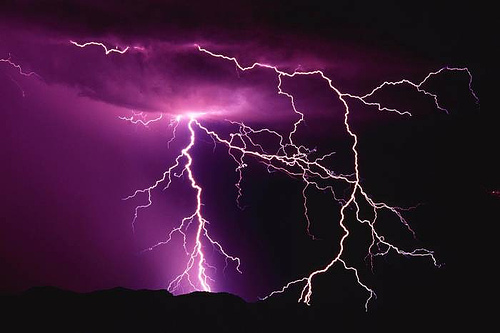Every outdoor antenna should be grounded. No exceptions. If it’s up on the roof and it’s made of metal, it should be grounded. Never mind if that antenna has been up there for 50 years and it’s always been fine. It’s never too late to do the right thing.
Why do lightning strikes happen?
(Beware, I’m simplifying a lot of this stuff. I’m sure that if you want to get into a Ph.D. level discussion of physics someone out there can explain it a lot more precisely.)
You might remember being told in school that lightning is like the shock you get when you shuffle across the carpet and touch a doorknob. That’s true, but there’s a little more than that.
Weather happens because the sun warms part of the planet more than other parts of the planet. The sun is the basis of all weather on earth, in fact. When one part of the planet gets warm, the air heats up and rises. Colder air comes in to fill the void. That’s how we get wind, and with wind comes the collision of cold and warm air masses. When a warm, humid mass of air hits a cold one, it can no longer hold as much water and that water falls down as rain or snow.
It’s weird to think of air masses rubbing together, because you can’t really feel a mass of air unless it’s moving. However we’re talking about really big masses of air and how they work. It’s a little hard to wrap your head around because you can’t feel an air mass that’s 100 miles on one side. Not all at once anyway.
When those air masses collide, some of the kinetic energy (the energy that moves the air) changes to static electricity. See, if you’re really going to get into it, you have to understand that you don’t “create” electricity or energy. You transfer it from one source to another. The sun’s energy, triggered by atomic fusion, gets transferred to the air, which moves. Some of that energy changes to static electricity when it can’t move the way it wants.
What is static electricity?
We all think we understand static electricity. It’s the shock you feel when you touch a doorknob. Static electricity holds two socks together in the dryer. It’s what generates random patterns on the TV screen. But those are effects of static electricity, not a definition of static electricity. Static electricity is the potential energy held by an object (your finger, your socks, the air). It’s transferred when kinetic energy (the energy of movement) is stopped due to friction (something rubbing against something else.)
The amount of static electricity that an object can hold depends on a lot of factors. Static electricity sits within an object until it can transfer to something that can hold more energy. This is called electrical discharge. It’s the spark you see, it’s also the bolt of lightning in the sky.
Electrical discharge happens when an object is holding as much static electricity as it can, and it approaches something that makes energy transfer easier. For example, a metal doorknob conducts electricity better than your finger. So, the energy transfers to the doorknob when you get close enough that the energy can overcome the resistance of the air between you.
Lightning is the same way. The air gains static electricity until it is close to being unable to hold more. When the air can’t hold any more electricity, it discharges onto the closest, most conductive thing. If that means a big stick of metal up on your roof, that’s a dangerous lightning strike.
How does grounding prevent lightning strikes?
Grounding prevents lightning strikes by providing a path from the pole on your roof to the ground. It doesn’t actually stop electricity from being transferred. It actually encourages the transfer of electricity much sooner before it becomes a problem. Grounding a pole makes for less resistance and tiny electrical charges pass from the sky to the ground easily. In that way they don’t build up and become a big giant lightning strike.
In the case of an actual lightning strike, if that pole is still the most conductive thing, the electricity has a path to travel. However the hope is that it doesn’t get to that point. Lightning is so powerful that a strike would easily burn through your roof even if you are properly grounded. The lightning would heat up the pole, melt the copper wire, and it would not be fun.
Get the supplies you need at Solid Signal
Solid Signal has the best selection of grounding supplies. Your local city hall or a licensed contractor can tell you what you’ll need in order to properly ground your antennas. Yes, it’s a little pricey because copper is the best material for grounding and it isn’t cheap. However, it’s a lot cheaper than replacing your house.





